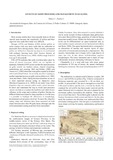Mostrar el registro sencillo del ítem
Effects of slope processes and management in gullying
| dc.creator | Desir, G. | es_ES |
| dc.creator | Marín, C. | es_ES |
| dc.date.accessioned | 2018-02-20T07:39:40Z | |
| dc.date.available | 2018-02-20T07:39:40Z | |
| dc.date.issued | 2007 | |
| dc.identifier.isbn | 978-84–9769-198-7 | |
| dc.identifier.uri | https://hdl.handle.net/2454/27377 | |
| dc.description | Resumen del trabajo presentado al IV International Symposium on Gully Erosion, celebrado en la Universidad Pública de Navarra del 17 al 19 de septiembre de 2007. | es_ES |
| dc.description.abstract | Most erosion studies have been typically done in rill and interrill areas because the complexity of gullies and their large size have made their study very difficult. Morgan (1979) and Hudson (1985) define gullies as water courses with very steep walls that are submitted to spasmodic flows during storms. More recently, permanent gullies are defined as channels too deep to be ameliorated with ordinary farming tools (Soil Science Society of America, 2001; Poesen et al., 2003). Gullies range from 0.5 m to up 25-30 m depth. FAO (1978) indicates that gully evolution takes place by means of several processes, which can act together or separately. Schnabel (1997) points out that the main processes on gully erosion are headcut retreat, channel deepening, undermining and scouring. Bull and Kirkby (2002) and Poesen et al., (2002) show that most gullies expand by headcut retreat and sidewall retreat. In our study area there is piping as another important process on gully erosion (Desir et al., 2005; Desir and Marín, 2006). Piping has been described as one of te most important process acting on dispersive clays (Martínez-Casanovas et al., 2004). In our study 7area where dispersive clays are common gullies reach a great extension. To know and understand the way in which each processes interact can help us to explain the landform and which factors influence on the origin and evolution of gullies. Having two different behaviours related to slope exposure as it is the case, it is possible to highlight the differences in morphology, development and processes involved. To reach this objective piping, slope and thickness have been measured on both slopes between more than 90 gully heads although only the most representative piping areas have been represented. | en |
| dc.format.extent | 2 p. | |
| dc.format.mimetype | application/pdf | en |
| dc.language.iso | eng | en |
| dc.publisher | Universidad Pública de Navarra / Nafarroako Unibertsitate Publikoa | es |
| dc.relation.ispartof | Javier Casalí, Rafael Giménez (eds.): Progress in Gully Erosion Research. IV International Symposium on Gully Erosion. September 17-19, 2007. Pamplona, Spain. Pamplona: Universidad Pública de Navarra / Nafarroako Unibertsitate Publikoa, 2007 | es |
| dc.rights | © Autores; Universidad Pública de Navarra. Esta publicación no puede ser reproducida, almacenada o transmitida total o parcialmente, sea cual fuere el medio y el procedimiento, incluidas las fotocopias, sin permiso previo concedido por escrito por los titulares del copyright. | es_ES |
| dc.subject | Piping | en |
| dc.subject | Slopes | en |
| dc.subject | Gully erosion | en |
| dc.title | Effects of slope processes and management in gullying | en |
| dc.type | info:eu-repo/semantics/conferenceObject | en |
| dc.type | Contribución a congreso / Biltzarrerako ekarpena | es |
| dc.rights.accessRights | info:eu-repo/semantics/openAccess | en |
| dc.rights.accessRights | Acceso abierto / Sarbide irekia | es |
| dc.type.version | info:eu-repo/semantics/publishedVersion | en |
| dc.type.version | Versión publicada / Argitaratu den bertsioa | es |


